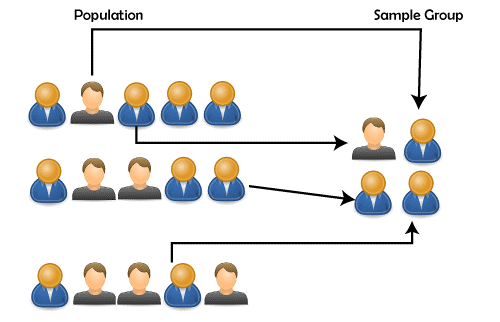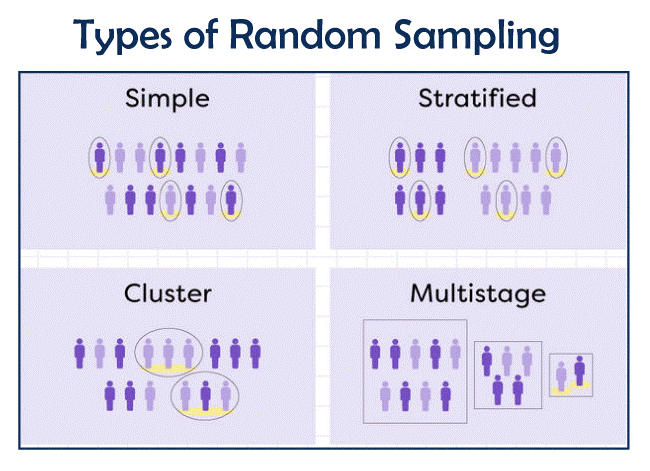Advantages and Disadvantages of Simple Random SamplingSimple random sampling (SRS) is a widely used method of selecting a sample from a population. 
Advantages of simple random sampling1. Ensures equal chance of selectionThe main advantage of SRS is that it ensures that each member of the population has an equal chance of being selected, which leads to a representative sample of the population. This is important because it allows for accurate estimation of population characteristics and unbiased inference. 2. Easy to understand and implementAnother advantage of SRS is that it is easy to understand and implement. This makes it a popular choice for researchers who are new to sampling or who have limited resources. 3. Versatile methodAdditionally, SRS is a versatile method that can be used for both large and small populations, and it can be used to sample from both homogeneous and heterogeneous populations. Disadvantages of simple random samplingOverall, simple random sampling is a widely used and effective method of selecting a sample from a population. However, it has some limitations and disadvantages that must be taken into consideration when designing a study. Researchers should carefully consider the characteristics of their population and the goals of their study when selecting a sampling method. 1. Time-consumingOne of the main disadvantages of SRS is that it can be time-consuming and costly to identify and contact every member of the population. This is especially true for large populations or populations that are spread out geographically. Additionally, SRS can lead to sampling errors if the sample is not large enough or if the population is not randomly distributed. This can result in a sample that is not representative of the population, which can lead to inaccurate conclusions. 
2. Difficult to achieve a good sampleAnother disadvantage of SRS is that it can be difficult to achieve a good sample size, especially for small populations. This can lead to low precision and unreliable estimates. Additionally, in some cases, SRS can lead to a sample that is not diverse enough to be representative of the population. 3. Do not consider heterogeneous populationAnother disadvantage is that SRS assumes that the population is homogeneous. However, if the population is heterogeneous, the sample may not be representative of the population. In such a case, stratified random sampling or cluster sampling may be more appropriate. 4. Difficult to achieve a good sample sizeAnother potential disadvantage of SRS is that it can be difficult to achieve a good sample size, especially for small populations. This can lead to low precision and unreliable estimates. Additionally, in some cases, SRS can lead to a sample that is not diverse enough to be representative of the population. 5. Difficult to obtain a responseAnother disadvantage is that it can be difficult to obtain a response from every member of the population. This can lead to non-response bias and make it difficult to estimate population characteristics. In such cases, researchers may need to use more sophisticated sampling methods such as weighting or multiple imputation to account for non-response bias. 6. Affected by non-response biasAnother limitation of SRS is that it can be affected by non-response bias. This occurs when some individuals in the population are not included in the sample because they cannot or will not respond to the survey. This can lead to a biased sample if the individuals who do not respond are systematically different from those who do respond. Researchers can use weighting or multiple imputation methods to account for non-response bias, but these methods can be complex and time-consuming. 7. Not suitable for all type of researchesAnother potential disadvantage of SRS is that it may not be appropriate for certain types of research. For example, if the population is divided into subgroups (e.g. age groups, gender, etc.) and researchers need to make inferences about these subgroups, stratified random sampling may be more appropriate. In this method, the population is divided into strata (subgroups) and a sample is selected from each stratum. This can ensure that the sample is representative of each subgroup and allows for more accurate estimates of subgroup characteristics. Alternative of sampling methodAnother alternative sampling method is cluster sampling, which is used when the population is naturally divided into clusters (e.g. schools, neighborhoods, etc.). In this method, clusters are randomly selected and all individuals within those clusters are included in the sample. This can be more cost-effective and efficient than SRS, especially for large populations. ConclusionIn conclusion, while SRS is a widely used and effective method of selecting a sample from a population, it has some limitations and disadvantages. Researchers should carefully consider the characteristics of their population and the goals of their study when selecting a sampling method. Alternative methods such as stratified random sampling and cluster sampling may be more appropriate in certain situations and can help to overcome the limitations of SRS. Additionally, they should consider the potential sources of bias and take steps to minimize them to ensure that the sample is representative of the population and the findings are reliable. |
 For Videos Join Our Youtube Channel: Join Now
For Videos Join Our Youtube Channel: Join Now
Feedback
- Send your Feedback to [email protected]
Help Others, Please Share









